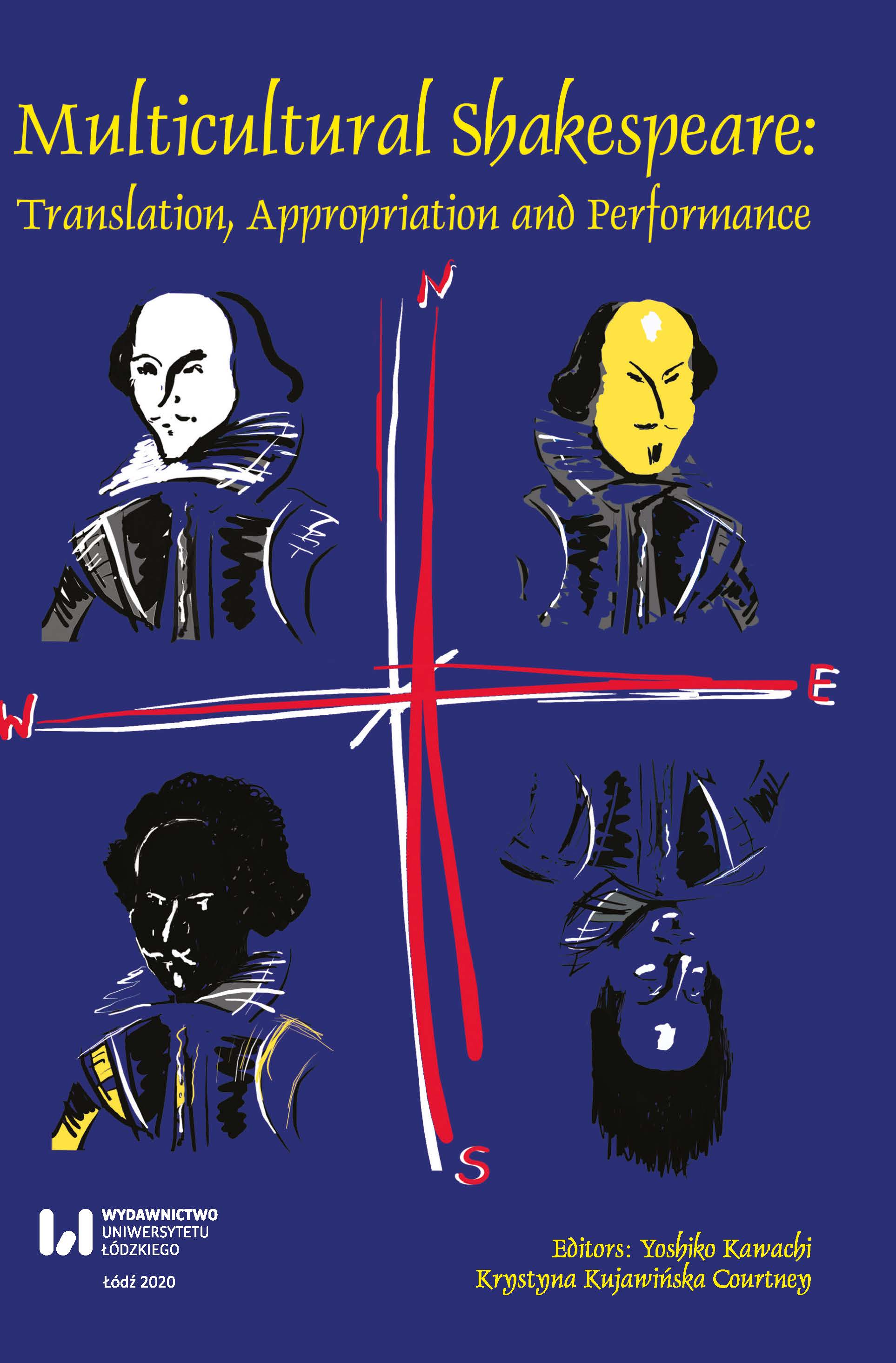Designing Goddesses: Shakespeare’s "Othello" and Marian Nowiński’s "Otello Desdemona"
DOI:
https://doi.org/10.18778/2083-8530.21.09Keywords:
Desdemona, William Shakespeare, Othello, Marian Nowiński, Shakespeare in visual artsAbstract
The article discusses the intertextual relationship between the poster by Marian Nowiński, Otello Desdemona, and the content of Shakespeare’s play, while presenting the most important elements of the plot that are decisive for the portrayal of Desdemona. It also discusses the tradition of female nudes in Western art. This allows to usher out these characteristic features of elements of Desdemona that fashion her into Venus Caelestis and Venus Naturalis. The article focuses on the ambivalence of Nowiński’s poster and discusses the significance of the paintings by Titian, Giorgione, and Fuseli in designing the figure of Desdemona as a goddess.
Downloads
References
Arassel, Daniel. Detal. Historia Malarstwa w Zbliżeniu. Trans. Anna Arno. Kraków: DodoEditor, 2013.
Google Scholar
Arassel, Daniel. Nie Widać Nic. Opowiadanie Obrazów. Trans. Anna Arno. Kraków: DodoEditor, 2012.
Google Scholar
Aristotle. “The Poetics of Aristotle.” The Gutenberg EBook of Poetics, by Aristotle. Trans. S.H. Butcher. 2008. 5 May 2017. https://www.amherst.edu/system/files/media/1812/The%252520Poetics%252520of%252520Aristotle%25252C%252520by%252520Aristotle.pdf
Google Scholar
Bartels, Emily C. “Strategies of Submission: Desdemona, the Duchess, and the Assertion of Desire.” Studies in English Literature, 1500-1900 36.2 (1996): 417-433.
Google Scholar
DOI: https://doi.org/10.2307/450956
Barthes, Roland. “The Death of the Author.” Image Music Text. London: Fontana Press, 1977. 142-148.
Google Scholar
DOI: https://doi.org/10.1007/978-1-349-03518-2
Berger, John. Ways of Seeing. London: BBC and Penguin Books, 2008.
Google Scholar
Chappell, Miles L. “Fuseli and the ‘Judicious Adoption’ of the Antique in the ‘Nightmare.’” The Burlington Magazine 128.999 (1986): 421-422.
Google Scholar
Dennis-Bryan, Kim, et al., editors. Signs & Symbols. An Illustrated Guide to Their Origins and Meanings. Ed. Dennis-Bryan, Kim, et al. London: Penguin Company, 2009.
Google Scholar
Garner, Shirley N. “Shakespeare’s Desdemona.” Shakespeare Studies 9 (1976): 233-252.
Google Scholar
Hagen, Rose-Marie, and Rainer Hagen. What Great Paintings Say. From the Bayeux Tapestry to Diego Rivera – Volume I. Koln: TASCHEN, 2005.
Google Scholar
Hallstead, R. N. “Idolatrous Love: A New Approach to Othello.” Shakespeare Quarterly 19.2 (1968): 107-124.
Google Scholar
DOI: https://doi.org/10.2307/2868208
Holmer, Joan Ozark. “Desdemona, Woman Warrior: ‘O, These Men, These Men!’ (4.3.59).” Medieval & Renaissance Drama in England 17 (2005): 132-164.
Google Scholar
Honigmann, E. A. J. Introduction. Othello. Ed. E. A. J. Honigmann. London: Arden Shakespeare, 1996. 1-111.
Google Scholar
Hopkins, Lisa. “Love and War on Venus’ Island: Othello and The Lover’s Melancholy.” Journal of Mediterranean Studies 25.1 (2016): 51-63.
Google Scholar
Kennedy, Ian G. Titian circa 1490-1576. Koln: TASCHEN, 2006.
Google Scholar
Kirsch, Arthur. “The Polarization of Erotic Love in ‘Othello.’” The Modern Language Review 73.4 (1978): 721-740.
Google Scholar
DOI: https://doi.org/10.2307/3727589
Kobielus, Stanisław. Florarium Christianum. Symbolika Roślin – Chrześcijańska Starożytność i Średniowiecze. Tyniec: Wydawnictwo Benedyktynów, 2014.
Google Scholar
Kott, Jan. Szekspir Współczesny. Warszawa: Państwowy Instytut Wydawniczy, 1965.
Google Scholar
Kultermann, Udo. “Woman Asleep and the Artist.” Artibus et Historiae 11.22 (1990): 129-161.
Google Scholar
DOI: https://doi.org/10.2307/1483403
Kurpik, Maria. “Theatrical Poster of Inter-War Period in a Collection of the Wilanów Museum of Poster.” Polish Theatre Poster 1899-1999. Ed. Krzysztof Dydo. Kraków: Krzysztof Dydo Galeria Plakatu, 2000. 35-38.
Google Scholar
McKwin, Carole. “Intimate Conversations between Women in Shakespeares Plays.” The Woman’s Part: Feminist Criticism of Shakespeare. Ed. Carolyn Ruth Swift Lenz et al. Chicago: University of Illinois Press, 1980. 117-132.
Google Scholar
Mishra, Vijay. “The Gothic Sublime.” A New Companion to the Gothic. Chichester: WILEY Blackwell, 2015. 288-306.
Google Scholar
DOI: https://doi.org/10.1002/9781444354959.ch20
Myrone, Martin. “Henry Fuseli and Gothic Spectacle.” Huntington Library Quarterly 70.2 (2007): 289-310.
Google Scholar
DOI: https://doi.org/10.1525/hlq.2007.70.2.289
Neely, Thomas Carol. “Women and Men in Othello.” William Shakespeare’s Othello. Ed. Harold Bloom. New York: Chelsea House Publishers, 1987. 79-104.
Google Scholar
Neill, Michael. “Changing Places in Othello.” Shakespeare Survey. Cambridge: Cambridge University Press, 1984. 115-132.
Google Scholar
DOI: https://doi.org/10.1017/CCOL0521267013.012
Ronnberg, Ami. The Book of Symbols. Reflections on Archetypal Images. Ed. Ami Ronnberg. Koln: TASCHEN, 2010.
Google Scholar
Shakespeare, William. Othello. Ed. E. A. J. Honigmann. London: Arden Shakespeare, 1996.
Google Scholar
Shakespeare, William. Othello. Ed. E.A.J. Honigmann. London: Bloomsbury Aden Shakespeare, 2016.
Google Scholar
Sillars, Stuart. Painting Shakespeare. The Artist as Critic 1720-1820. Cambridge: Cambridge University Press, 2006.
Google Scholar
Stewart, Charles. “Erotic Dreams and Nightmares from Antiquity to the Present.” The Journal of the Royal Anthropological Institute 8.2 (2002): 279-309.
Google Scholar
DOI: https://doi.org/10.1111/1467-9655.00109
Thompson, Ayanna. Introduction. Othello. Ed. E.A.J. Honigmann. London: Bloomsbury Aden Shakespeare, 2016. 1-116.
Google Scholar
Ward, Maryanne C. “A Painting of the Unspeakable: Henry Fuseli’s ‘The Nightmare’ and the Creation of Mary Shelley’s ‘Frankenstein.’” The Journal of the Midwest Modern Language Association 33.1 (2000): 20-31.
Google Scholar
DOI: https://doi.org/10.2307/1315115
Wundram, Manfred. Renaissance. Ed. Ingo F. Walther. Koln: TASCHEN, 2006.
Google Scholar
Yachnin, Paul. “Magical Properties: Vision, Possession, and Wonder in ‘Othello.’” Theatre Journal 48.2 (1996): 197-208.
Google Scholar
DOI: https://doi.org/10.1353/tj.1996.0046
Ziemba, Antoni. Iluzja a Realizm. Gra z Widzem w Sztuce Holenderskiej 1580-1660. Warszawa: Wydawnictwo Uniwersytetu Warszawskiego, 2016.
Google Scholar
DOI: https://doi.org/10.31338/uw.9788323528050
Downloads
Published
How to Cite
Issue
Section
License

This work is licensed under a Creative Commons Attribution-NonCommercial-NoDerivatives 4.0 International License.












